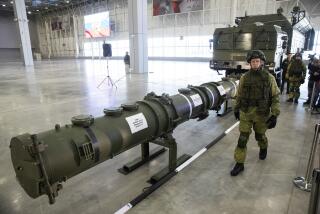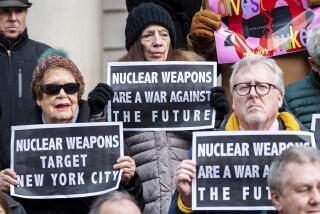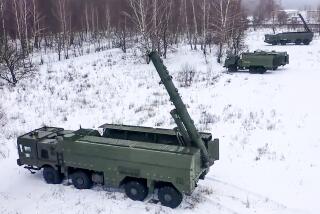Soviet Radar Site--Arms Issue Symbol : Facility Dramatizes Problem of Verifying Treaty Compliance
- Share via
WASHINGTON — In July, 1983, an American spy satellite for the first time detected a new radar installation growing out of the vast Siberian taiga near Krasnoyarsk, in the vicinity of key Soviet nuclear missile bases. It had been under construction for several years and must have been planned at least five years earlier, U.S. analysts concluded--at the very height of detente and in violation of the 1972 Anti-Ballistic Missile Treaty.
The structure, jutting 10 stories above the tundra, can be used as the “battle manager” of a nationwide network of anti-ballistic missiles when it becomes operational in 1987. It will be able to direct interceptor missiles toward incoming warhead targets, assessing kills and otherwise running the missile defense for much of Soviet Asia.
Early-Warning Function
By contrast, all U.S. ABM-capable radars are on the edge of the United States, looking outward to perform an early-warning function, as required by the treaty. U.S. officials thus view the Krasnoyarsk installation as the most certain, the most flagrant and the most threatening arms treaty violation by Moscow in the past decade. As such, it dramatizes the excruciating difficulties of verifying compliance with arms control agreements.
Daunting Obstacles
The problem of verification will be near the top of the list of daunting obstacles faced by U.S. and Soviet negotiators as they convene Tuesday in Geneva for yet another effort to fashion diplomatic limits on the nuclear weapons race.
The problems fall into three categories--political, technical and military.
The new political obstacles to verification are largely of the Reagan Administration’s own making. Under pressure from its conservative supporters but also in keeping with its own inclination, the Administration has publicly charged the Soviets with violations of existing treaties. But it has also done nothing about those violations.
That failure to act has prompted demands that the United States take steps to counteract the gains Moscow might have reaped from the violations. It also has contributed to profound doubts in some quarters about the wisdom of seeking new arms treaties at all.
“The U.S. government has no business negotiating new arms control agreements unless it has a responsible policy to deal with Soviet cheating on existing agreements,” said Colin S. Gray, president of the National Institute for Public Policy and a member of the President’s own General Advisory Committee on Arms Control and Disarmament.
The view from the left is not much more encouraging. “Unless the United States and the Soviet Union can work out mutually acceptable ways to verify new agreements and resolve compliance problems arising from previous accords, nuclear arms control will not have much of a future,” said Michael Krepon, a senior associate of the Carnegie Endowment for International Peace and head of its verification project.
Reagan Skirts Issue
President Reagan did not address the issue directly when asked recently whether he feared that the Soviet Union, which he has called an evil empire run by liars and cheats, would violate any new agreements.
“We know they have a past record of violating agreements,” he replied. “We know also that absolute verification is impossible, but verification to the extent possible is going to be a very necessary feature in our negotiations.”
Much as on arms control itself, the Administration seems split on how to handle compliance.
Pentagon officials say the United States should undertake “offsetting violations” to compensate for Soviet activities. The Arms Control and Disarmament Agency wants to make the clearing up of old charges a “prerequisite” for reaching new agreements. The State Department has a third approach.
Said Lt. Gen. John T. Chain Jr., director of the department’s bureau of politico-military affairs: “The solution is to draft treaty language which is clear in its objectives to both sides. Our negotiators in Geneva have been directed to take these (past) compliance findings into account and draft positions accordingly. They will also raise our concerns about past and current Soviet activities, in an effort to reverse erosion of the ABM treaty and seek satisfactory outcomes to our other concerns.
Krasnoyarsk Issue
“It will be difficult to move ahead in the defense and space forum without a satisfactory resolution of the Krasnoyarsk issue,” Chain said. Defensive and space weapons will be the subject of one of three simultaneous sets of negotiations in Geneva; the others will deal with long-range and intermediate-range offensive nuclear weapons.
And the United States will demand strict new verification provisions in the offensive weapons negotiations as well. Former Sen. John Tower of Texas, the chief U.S. negotiator on long-range nuclear weapons, said that satellites and other spy systems are not sufficient. “Other forms (of verification) must be employed,” he said, “including some intrusive forms.”
Officials described this as a thinly veiled call for on-site inspection of some kind. The Soviets have been more receptive in recent years to the principle of international inspectors on their territory but will undoubtedly resist the most intrusive forms, such as on-site inspection of suspicious activities, which they denounce as espionage.
There is considerable sentiment in the Reagan Administration for scrapping the mechanism, called the Standing Consultative Commission, set up by existing treaties for exchanging complaints about violations. “The SCC is a technical forum to deal with ambiguities,” Assistant Defense Secretary Richard N. Perle said. “The problem is violations.”
The Carter Administration, as it sought Senate ratification of the second strategic arms limitation treaty, or SALT II, in 1979, conceded that the Soviets had repeatedly exploited ambiguities in arms treaties. But either the Soviets had ceased all the activities that the United States had raised at the SCC, the Carter Administration said, “or subsequent information has clarified the situation and allayed our concern.”
‘Accepted Violations’
But Perle argued, with the support of the Administration’s chief arms adviser, Paul H. Nitze, that the Carter Administration resolved its concerns over compliance “by accepting what has been done in violation of the treaties.”
Amid such controversy, the Senate is certain to scrutinize any new agreement thoroughly and insist upon strong verification provisions--perhaps stronger than can be negotiated or are technically feasible--before ratifying any new treaties.
Beyond the political issues raised by verification, technical difficulties are increasingly formidable. Big new intercontinental ballistic missiles (ICBMs) are becoming mobile and harder to count, for example, and distinguishing between types of weapons is sometimes virtually impossible.
New, small, easily hidden cruise missiles can hit a ship 300 miles away with a conventional TNT warhead, or they can travel 3,000 miles from Western Europe to Moscow bearing a nuclear device. To a satellite, both look identical.
Moreover, although each side has invented precise and ingenious systems to spy on the other, their effectiveness is limited.
Cloudy Weather, Long Nights
Photo-reconnaissance satellites can resolve objects on Earth as small as four inches and identify the objects if they are four feet across. But cloudy weather and the long Arctic night over Siberia can foil the best systems, as the delayed detection of the Krasnoyarsk radar showed.
Man can also deliberately hide vital data, as the Soviets do by encoding radio signals from test flights despite a somewhat loose pledge to the contrary in the SALT II accord. Coding can make it impossible for the United States to determine whether a Soviet missile in the testing phase meets the definition of a “new” weapon--which would make it a violation of SALT II--rather than a modification of an old missile--which is permitted.
If nature and man did not interfere, some key weapons data would still not be precisely known. Accuracy would be apparent only if the Soviets announced the precise targets of their missile tests. And the number of small anti-missile interceptors already built but not yet deployed cannot be known without visiting production and storage facilities.
Even on-site inspection can fail. Inspectors can be certain of conditions, such as the absence of weapons, only for as long as they are present.
As for the military implications of verification, none of the 14 arms control violations--rated as certain, probable, possible or questionable--with which the Administration has charged the Soviets has so far done any damage.
No Harm to Security
“Our security has not yet suffered because of Soviet noncompliance,” Kenneth L. Adelman, director of the Arms Control and Disarmament Agency, said. So far, the Pentagon has not decided to seek additional funds for compensating military programs, such as decoys or maneuvering warheads.
But the Krasnoyarsk radar, situated near key Soviet ICBM bases, could be different. If the Soviets decided to “break out” of the ABM treaty by building a missile defense network in the next few years, Krasnoyarsk could become a key “battle management” unit.
“There’s no way to understand that radar except that the ABM treaty has low priority to the Russians,” said one key Administration arms control specialist. “They could have built it on the periphery, at somewhat higher cost, to comply with the agreement. The dozen or so other violations represent a breakdown in our ability to resolve irritations, but Krasnoyarsk is in a different category. It is a very disturbing development.”
At a time when new arms agreements are exceedingly difficult to negotiate and ratify, much less to verify, a growing body of opinion holds that the superpowers should shy away from such agreements and perhaps rely instead on unilateral announcements of their weapons systems--”arms control by press release,” as some have dubbed it.
“Each side would take measures which enhance strategic stability and reduce nuclear weapons in consultation with each other--but not necessarily in a formalized, signed agreement,” Adelman recently wrote in Foreign Affairs. “Individual, parallel restraint could help avoid endless problems over what (weapons) programs to exclude, which to include and how to verify them.”
But the Administration has decided instead to seek new formal accords through negotiations, complete with verification provisions. That promises to make compliance an even greater problem in Soviet-American relations.
More to Read
Sign up for Essential California
The most important California stories and recommendations in your inbox every morning.
You may occasionally receive promotional content from the Los Angeles Times.










